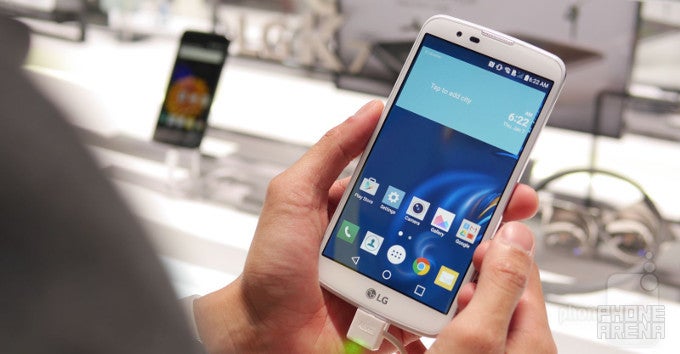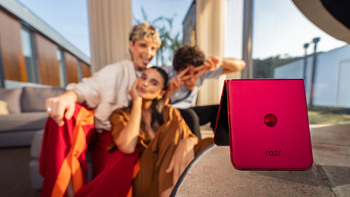LG K10 hands-on

Design
While the styling of the LG K10 is unlikely to win it any medals, it's hard not to appreciate what it brings to the table, еspecially considering it's got the lower-end segment in its sight. Featuring slightly updated, but signature design language, the K10 is every bit an LG device, with an ergonomic, rounded back covered in a fine woven texture. As LG users would expect, the volume and power keys are relegated to the rear—a unique feature of the company's devices ever since the LG G2, of which the K10 is kind of reminiscent.
LG calls this "pebble" design, and we like what the company has managed here. In an increasingly cutthroat market, even the lowest of low-ends have to bring it in order to have a chance. At least in terms of looks, the K10 checks that box.
Display
LG settled on a relatively large, 5.3-inch "in-cell" TFT LCD display with a resolution of 720 x 1280 pixels. This combination yields a pixel density of nearly 280 pixels per inch, which is pretty decent for this class. As for the in-cell part, it simply means that the touch sensor and the LCD panel are molded together, reducing the thickness of the entire assembly. The practical user benefits from this are thinner relative devices and a more compelling touch experience as you feel like you're actually interacting with the content on the screen instead of just tapping on a slab of glass.
Speaking of glass, LG hasn't mentioned anything in terms of what's protecting the 5.3-incher, so we're assuming there's no Gorilla Glass of any kind here, but rather a more generic solution.
Interface
Like all LG devices, the K10 comes packing the company's proprietary overlay, which tends to be a bit on the heavy side, but balances this out by offering extra functionality. Of course, don't go expecting that the K10 will support the full lineup of features that the high-end G line does. Rather, some of the features have been axed.
The Android build the software is based on is Android 5.1 Lollipop, and at this point we have no relevant information in terms of future software support and possible upgrade to Android 6.0 Marshmallow.
Processor and memory
Three versions of the K10 will be made available. Depending on the region, you'll either get a 3G- or a 4G LTE-enabled K10, so similar processors, but still different. From what we're told, we're talking about either a quad-core chip at 1.2GHz or 1.3GHz for the LTE version, and a 1.3GHz one for the 3G model. The exact make wasn't specified, but we speculate that it's likely Qualcomm Snapdragon silicon we have here, more specifically 400 series units, but we can't be sure.
On the memory front, we've got similar fragmentation. The 3G model will offer 1GB of RAM and 8GB of storage, while the two LTE models will be split into 1.5GB/16GB and 2GB/16GB RAM/storage combos.
Camera
Looking at the cameras, the confusing split between models continues. The top LTE model will come packing a 13-megapixel main camera, while an 8-megapixel unit will take up the front, while the slightly inferior LTE version will substitute that selfie cam for a 5-megapixel snapper. The 3G model will fetch an 8MP/8MP combo, which is kind of interesting—we don't generally get to see as pixel-rich selfie cams in this segment.
Expectations
LG is keeping mum on details pertaining to pricing and availability, but we can certainly speculate. Given the marginally different models, it's quite likely that the 3G flavor will be aimed at emerging markets—perhaps in Asia and Latin America—while the higher end, LTE versions will be aimed at European and North American customers. Depending on how these are priced, they could end up enjoying some success as carrier offerings.











Things that are NOT allowed: